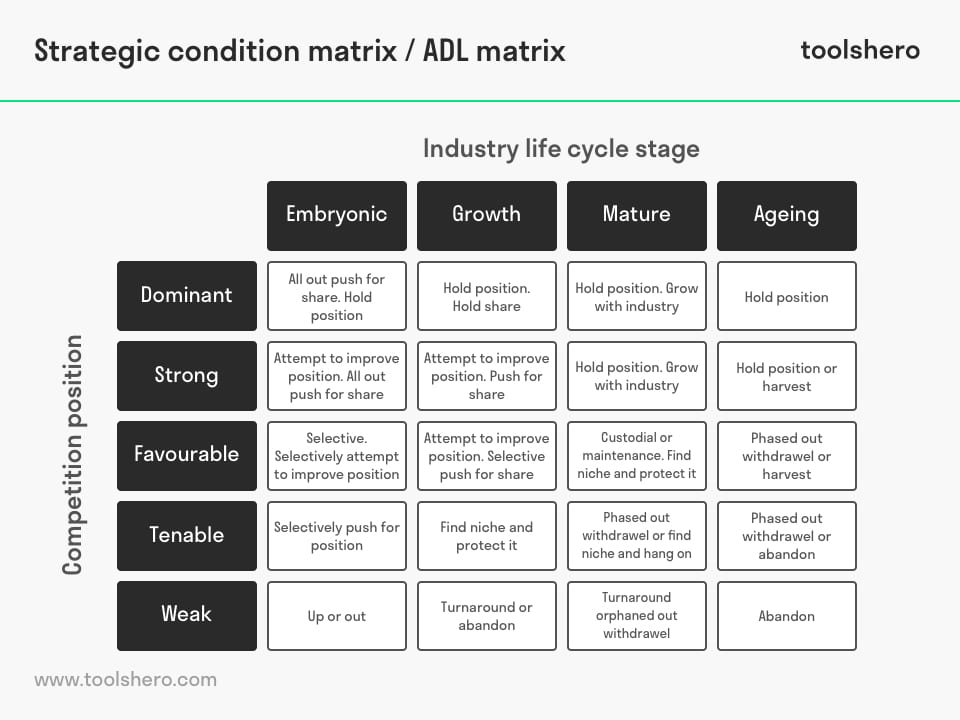ADL Matrix by Arthur D. Little explained

ADL Matrix: this article explains the ADL Matrix, developed by Arthur D. Little, in a practical way. The article contains a practical explanation of the matrix, the answer to 2 very important questions regarding the ADL matrix and the four stages of maturity. Enjoy reading!
What is the ADL Matrix?
To gain more insight into the competitive position of organizations, Arthur D. Little developed the strategic condition matrix, which is also known as the ADL Matrix.
This matrix consists of two important dimensions: the competitive position and industry maturity (maturity of the product).
ADL Matrix, two questions
Industry maturity is similar to the Product Life Cycle (PLC) and is translated into an Industry life cycle of a product in this Matrix.
When investigating the concepts of the competitive position it is important to answer the following two questions:
- How strong is the organization’s strategic position?
- At what stage of its lifecycle is the industry/segment?
In the model below, Arthur D. Little ‘s ADL matrix is highlighted, in which the combination of various stages in the competitive position and in the industry maturity are decisive for an organization’s strategy:

Figure 1 – ADL matrix
Industrial maturity
There are four categories of industry maturity:
Embryonic stage
The introduction of the product is characterized by a rapid growth market, very little competition and (still) high sales prices.
Growth stage
The market continues to strengthen and sales increase, there are few (if any) competitors.
Maturity stage
The market and market shares are stable, there is an established customer base and the price is lowered because of the growing competition.
Ageing stage
The demand for the product decreases and companies are abandoning the market. Companies stop consolidating or leave the market.
Competitive position vai the ADL matrix
Arthur D. Little formulated five categories for the competitive position within the ADL matrix:
Dominant
At this stage there is little or no competition because a brand-new or unknown product is brought to market.
Strong
The market share is strong and stable, regardless of what the competition is doing.
Favourable
The organization enjoys competitive advantages in certain segments of the market. There are many competitors.
Tenable
The position of the organization in the overall market is small and market share is based, among other things, on a niche or some other form of product differentiation.
Weak
The organization experiences continual loss of market share and it business line is too small to maintain profitability.
It’s Your Turn
What do you think? Is the ADL Matrix applicable in today’s modern economy and marketing? Do you recognize the practical explanation or do you have more suggestions? What are your success factors for the good ADL Matrix set up?
Share your experience and knowledge in the comments box below.
More information
- Hax, A. C., & Majluf, N. S. (1983). The life-cycle approach to strategic planning (pp. 1-36). Massachusetts Institute of Technology.
- Proctor, T. (2014). Strategic marketing: an introduction. Routledge.
- Sirkis, R. L., Race, S. M., & Little, A. D. (1981). Principles of Strategic Planning for the Food-Service Firm How to select a strategy based on your competitive position in the industry. Cornell Hotel and Restaurant Administration Quarterly, 22(1), 35-41.
How to cite this article:
Van Vliet, V. (2011). ADL Matrix (Little). Retrieved [insert date] from Toolshero: https://www.toolshero.com/strategy/adl-matrix/
Original publication date: 03/03/2011 | Last update: 11/13/2023
Add a link to this page on your website:
<a href=”https://www.toolshero.com/strategy/adl-matrix/”>Toolshero: ADL Matrix (Little)</a>












